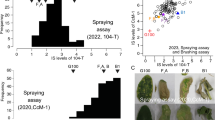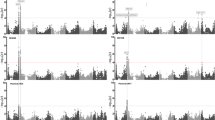Abstract
Reciprocal F1, F2 and F3 populations of lentil (Lens culinaris Medik.) were developed by crossing between lines, with a chloroplastic psbA gene mutation conferring tolerance to the photosystem II inhibitor herbicide metribuzin, and sensitive parent PBA Flash, to understand the genetic control of the herbicide tolerance. Additionally, reciprocal BC1F2 populations were developed to identify any fitness penalty associated with the metribuzin tolerance. Phenotyping and genotyping results of the F1, F2, and F3 populations identified a predominantly maternal inheritance pattern, but with a level of paternal leakage. Paternal leakage occurred in approximately 20% of F1 phenotypes, when including lines showing heteroplasmy (the existence of maternal and paternal chloroplasts within an individual). Field experiments with BC1F2 and BC1F3 lines confirmed this biparental inheritance pattern. Grain yield was reduced by 20–40% in metribuzin tolerant backcrossed lines compared with sensitive lines. Net assimilation rate at the onset of anthesis and plant dry weight at mid anthesis and maturity were also reduced in the tolerant lines suggesting reduced photosynthetic efficiency associated with the metribuzin tolerance results in lower dry weight and grain yield in the tolerant lines. The mode of inheritance and associated yield penalty of the tolerance trait will complicate its introgression in lentil breeding programs. However, the high level of tolerance and unique weed control benefits of this trait suggest that this form of metribuzin tolerance in lentil, which is similar to triazine tolerant canola (Brassica napus L.), could be adopted.


Similar content being viewed by others
Availability of data and material
The translated amino acid sequence from M009, M043 and the susceptible parent PBA Flash are available in the GenBank database as MH681284, MH681285 and MH681286. All data from this research is deposited with the University of Adelaide data depository and can be made available upon request.
References
Beversdorf WD, Kott LS (1987) Development of triazine resistance in crops by classical plant breeding. Weed Sci 35:9–11
Beversdorf WD, Hume DJ, Donnelly-Vanderloo MJ (1988) Agronomic performance of triazine-resistant and susceptible reciprocal spring canola hybrids. Crop Sci 28:932–934
Bhatty RS (1988) Composition and quality of lentil (Lens culinaris Medik): a review. Can Ins Food Sci Technol J 11:144–160
Birky CW (2001) The inheritance of genes in mitochondria and chloroplasts: laws, mechanisms, and models. Annu Rev Gen 35:125–148
Boutsalis P, Gill G, Preston C (2016) Risk of addiction to IMIs (Group B imidazolinone herbicides). In: 2016 Grains Research and Development Corporation Grains Research Update, Adelaide, Informed decisions—driving change. GRDC, Adelaide, pp 241–243
Brand J, Yaduraju NT, Shivakumar BG, McMurray L (2007) Weed management. In: Yadav SS, McNeil DL, Stevenson PC (eds) Lentil an ancient crop for modern times. Springer, Dordrecht, pp 159–172
Butler DG, Cullis BR, Gilmour AR, Gogel BJ, Thompson R (2017) ASREML-R reference manual version 4. VSN International Ltd, Hemel Hempstead, Brisbane, p 176
Cannell RQ (1967) Net assimilation rate in barley, oats and wheat. J Agric Sci Camb 68:157–164
Corriveau JL, Coleman AW (1988) Rapid screening method to detect potential biparental inheritance of plastid DNA and results for over 200 angiosperm species. Am J Bot 75:1443–1458
Devine MD, Shukla A (2000) Altered target sites as a mechanism of herbicide resistance. Crop Prot 19:881–889
Doyle JJ, Doyle JL (1987) CTAB DNA extraction in plants. Phytochem Bull 19:11–15
Duke SO (2005) Taking stock of herbicide resistant crops ten years after introduction. Pest Manag Sci 61:211–218
Ellis JR, Bentley KE, McCauley DE (2008) Detection of rare paternal chloroplast inheritance in controlled crosses of the endangered sunflower Helianthus verticillatus. Heredity 100:574–580
Erskine W, Muehlbauer FJ, Short RW (1990) Stages of development in lentil. Exp Agric 26:297–302
FAOSTAT (2019) Food and Agriculture Organization of the United Nations, Statistics Division, Rome, Italy Production crops. FAOSTAT statistics database. http://www.fao.org/faostat/en/#data/QC. Accessed 10 May 2019
Frey JE (1998) Genetic flexibility of plant chloroplasts. Nature 398:115–116
Fuerst EP, Norman MA (1991) Interaction of herbicides with photosynthetic electron transport. Weed Sci 39:458–464
Gilmour AR, Cullis BR, Verbyla AP (1997) Accounting for natural and extraneous variation in the analysis of field experiments. J Agric Biol Environ Stat 2:269–293
Greiner S, Sobanski J, Bock R (2015) Why are most organelle genomes transmitted maternally? BioEssays 37:80–94
Horlow C, Goujaud J, Lepingle A, Missonier C, Bourgin JP (1990) Transmission of paternal chloroplasts in tobacco (Nicotiana tabacum). Plant Cell Rep 9:249–252
Lee DJ, Blake TK, Smith SE (1988) Biparental inheritance of chloroplast DNA and the existence of heteroplasmic cells in alfalfa. Theor Appl Genet 76:545–549
Masoud SA, Johnson LB, Sorenson EL (1990) High transmission of paternal plastid DNA in alfalfa plants demonstrated by restriction fragment polymorphic analysis. Theor Appl Genet 79:49–55
Materne M, McMurray L, Brouwer J, Bretag T, Brand J, MacLean B, Hawthorne W (2011) Lentil in Australia. Grain Legumes 57:52–55
McCauley DE (2013) Paternal leakage, heteroplasmy, and the evolution of plant mitochondrial genomes. New Phytol 200:966–977
McCullagh P, Nelder J (1989) Generalized linear models, 2nd edn. Chapman & Hall/CRC, Boca Raton, pp 98–135
McDonald GK, Hollaway KL, McMurray L (2007) Increasing plant density improves weed competition in lentil (Lens culinaris). Aust J Exp Agric 47:48–56
McMurray LS, Preston C, Vandenberg A, Mao D, Oldach KH, Meier KS, Paull JG (2019a) Development of high levels of metribuzin tolerance in lentil. Weed Sci 67:83–90
McMurray LS, Preston C, Vandenberg A, Mao D, Bett KE, Paull JG (2019b) Induced novel psbA mutation (Ala251 to Thr) in higher plants confers resistance to PSII inhibitor metribuzin in Lens culinaris. Pest Manag Sci 75:1564–1570. https://doi.org/10.1002/ps.5328
Mengistu LW, Mueller-Warrant GW, Liston A, Barker R (2000) psbA mutation (valine219 to isoleucine) in Poa annua resistant to metribuzin and diuron. Pest Manag Sci 56:209–217
Mengistu LW, Christoffers MJ, Lym RG (2005) A psbA mutation in Kochia scoparia (L) Schrad from railroad rights-of-way with resistance to diuron, tebuthiuron and metribuzin. Pest Manag Sci 61:1035–1042
Mohamed ES, Nourai AH, Mohamed GF, MohamedSaxena MMMC (1997) Weeds and weed management in irrigated lentil in northern Sudan. Weed Res 37:211–218
Murphy BP, Tranel PJ (2019) Target-site mutations conferring herbicide resistance. Plants 8:382. https://doi.org/10.3390/plants8100382
Park KW, Mallory-Smith C (2006) psbA mutation (Asn266 to Thr) in Senecio vulgaris L. confers resistance to several PS II-inhibiting herbicides. Pest Manag Sci 62:880–885
Perez-Jones A, Intanon S, Mallory-Smith C (2009) Molecular analysis of hexazinone-resistant Shepherd’s-Purse (Capsella bursa-pastoris) reveals a novel psbA mutation. Weed Sci 57:574–578
Powles SB, Yu Q (2010) Evolution in action: plants resistant to herbicides. Annu Rev Plant Biol 61:317–347
Preston C (2002) Managing an eternal pest—weeds. In: Brouwer JB (ed) Proceeding of lentil focus 2002. Pulse Austraila Ltd, Sydney
R Core Team (2020) R: a language and environment for statistical computing. R Foundation for Statistical Computing, Vienna
Rajora OR, Mahon JD (1995) Paternal plastid DNA can be inherited in lentil. Theor Appl Genet 90:607–610
Reith M, Straus NA (1987) Nucleotide sequence of the chloroplast gene responsible for triazine resistance in canola. Theor Appl Genet 73:357–363
Robertson MJ, Holland JF, Cawley S, Potter TD, Burton W, Walton GH, Thomas G (2002) Growth and yield differences between triazine-tolerant and non-triazine-tolerant cultivars of canola. Aust J Agric Res 53:643–651
Rochaix JD, Erickson J (1988) Function and assembly of photosystem II: genetic and molecular analysis. Trends Biochem Sci 13:56–60
Schneider A, Stelljes C, Adams C, Kirchner S, Burkhard G, Jarzombski S, Broer I, Horn P, Elsayed A, Hagl P, Leister D, Koop HU (2015) Low frequency paternal transmission of plastid genes in Brassicaceae. Transgenic Res 24:267–277
Schumann CM, Hancock JF (1989) Paternal inheritance of plastids in Medicago sativa. Theor Appl Genet 78:863–866
Schwenger-Erger C, Thiemann J, Barz W, Johanningmeier U, Naber D (1993) Metribuzin resistance in photoautotrophic Chenopodium rubrum cell cultures: characterization of double and triple mutations in the psbA gene. FEBS Lett 329:43–46
Tan GY, Tan WK (1981) Net assimilation rate and relative nitrogen assimilation rate in relation to the dry matter production of alfalfa cultivars. Plant Soil 59:185–192
Thiel H, Varrelmann M (2013) Identification of a new PSII target site psbA mutation leading to D1 amino acid Leu218Val exchange in the Chenopodium album D1 protein and comparison to cross-resistance profiles of known modifications at positions 251 and 264. Pest Manag Sci 70:278–285
Vernon AJ, Allison JCS (1963) A method of calculating net assimilation rate. Nature 200:814
Vila-Aiub MM, Neve P, Powles SB (2009) Fitness costs associated with evolved herbicide resistance alleles in plants. New Phytol 184:751–767
Watson DG (1952) The physiological basis of variation in yield. Adv Agron 4:101–145
Weihe A, Apitz J, Pohlheim F, Salinas-Hartwig A, Borner T (2009) Biparental inheritance of plastidial and mitochondrial DNA and hybrid variegation in Pelargonium. Mol Genet Genom 282:587–593
White B (2015) Field crop herbicide guide, 9th edn. Kondinin Group, Leederville, pp 456–462
Williams RF (1946) The physiology of plant growth with special reference to the concept of net assimilation rate. Ann Botany 10:41–72
Yenish JP, Brand J, Pala M, Haddad A (2009) Weed management. In: Erskine W, Muehlbauer FJ, Sarker A, Sharma B (eds) The lentil: botany, production and uses. CABI International, Wallingford, pp 326–342
Zhang Q, Liu Y, Sodmergen (2003) Examination of the cytoplasmic DNA in male reproductive cells to determine the potential for cytoplasmic inheritance in 295 angiosperm species. Plant Cell Phys 44:941–951
Zhang H, Berger JD, Seymour M, Brill R, Herrmann C, Quinlan R, Knell G (2016) Relative yield and profit of Australian hybrid compared with open-pollinated canola is largely determined by growing-season rainfall. Crop Pasture Sci 67:323–331
Acknowledgements
The Grains Research Development Corporation (GRDC), the South Australian Research and Development Institute (SARDI), the University of Adelaide, the Natural Sciences and Engineering Research Council of Canada (NSERC) and the Saskatchewan Pulse Growers (SPG) provided financial support for this study. The Plant Accelerator, Australian Plant Phenomics Facility, a research facility funded by the National Collaborative Research Infrastructure Strategy (NCRIS). Technical assistance and input were provided by Shi Ying Yang and Ruwan Lenorage of the University of Adelaide; Jamus Stonur, Kathy Fischer, Henk Venter, John Nairn, Phil Rundle, Brooke Schofield. Tim Jenkins, Parminder Sidhu of SARDI; and Robert Stonehouse, Vladimir Pajic, Kendra Meier, Brent Barlow, Devini De Silva, Chandra Bandara and Adam Harrison from the University of Saskatchewan. Dr Richard Jarret, University of Adelaide provided valuable contribution to the statistical analysis of the fitness cost field studies. No conflicts of interest have been declared.
Funding
The Grains Research Development Corporation (GRDC), the South Australian Research and Development Institute (SARDI), the University of Adelaide, the Natural Sciences and Engineering Research Council of Canada (NSERC) and the Saskatchewan Pulse Growers (SPG) provided financial support for this study. The Plant Accelerator, Australian Plant Phenomics Facility, a research facility funded by the National Collaborative Research Infrastructure Strategy (NCRIS).
Author information
Authors and Affiliations
Corresponding author
Ethics declarations
Conflicts of interest
The authors declare no conflicts of interest.
Additional information
Publisher's Note
Springer Nature remains neutral with regard to jurisdictional claims in published maps and institutional affiliations.
Rights and permissions
About this article
Cite this article
McMurray, L.S., Preston, C., Vandenberg, A. et al. Paternal leakage inheritance and a fitness cost are associated with the chloroplastic psbA gene controlled metribuzin tolerance in lentil (Lens culinaris). Euphytica 217, 103 (2021). https://doi.org/10.1007/s10681-021-02841-9
Received:
Accepted:
Published:
DOI: https://doi.org/10.1007/s10681-021-02841-9




